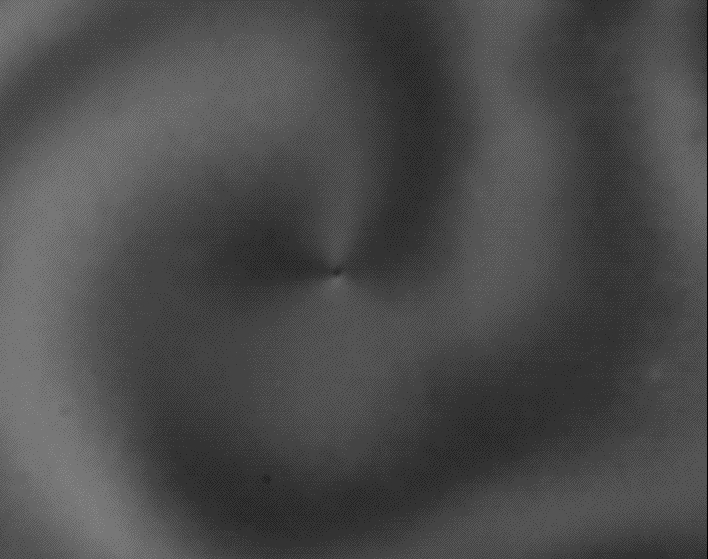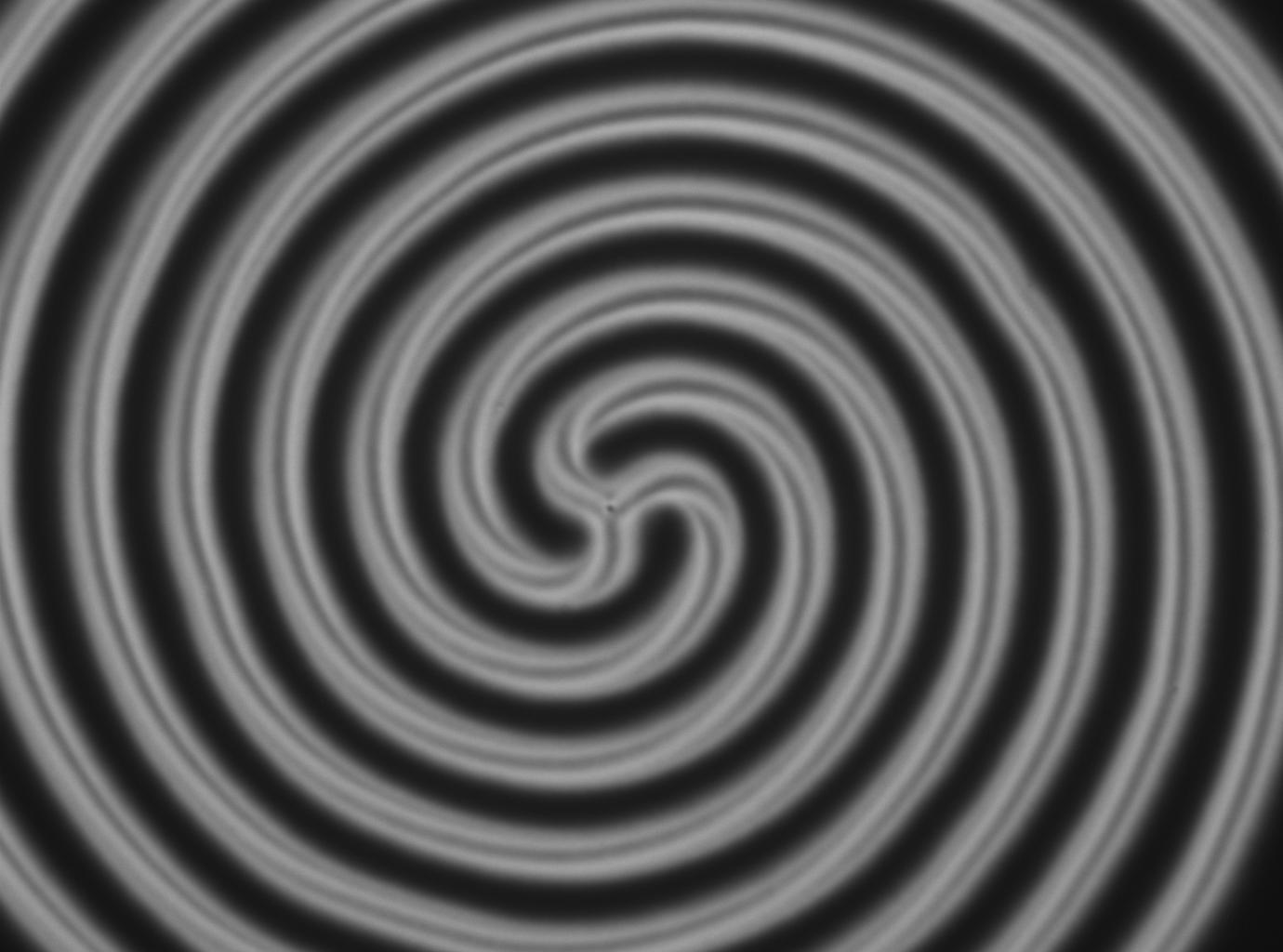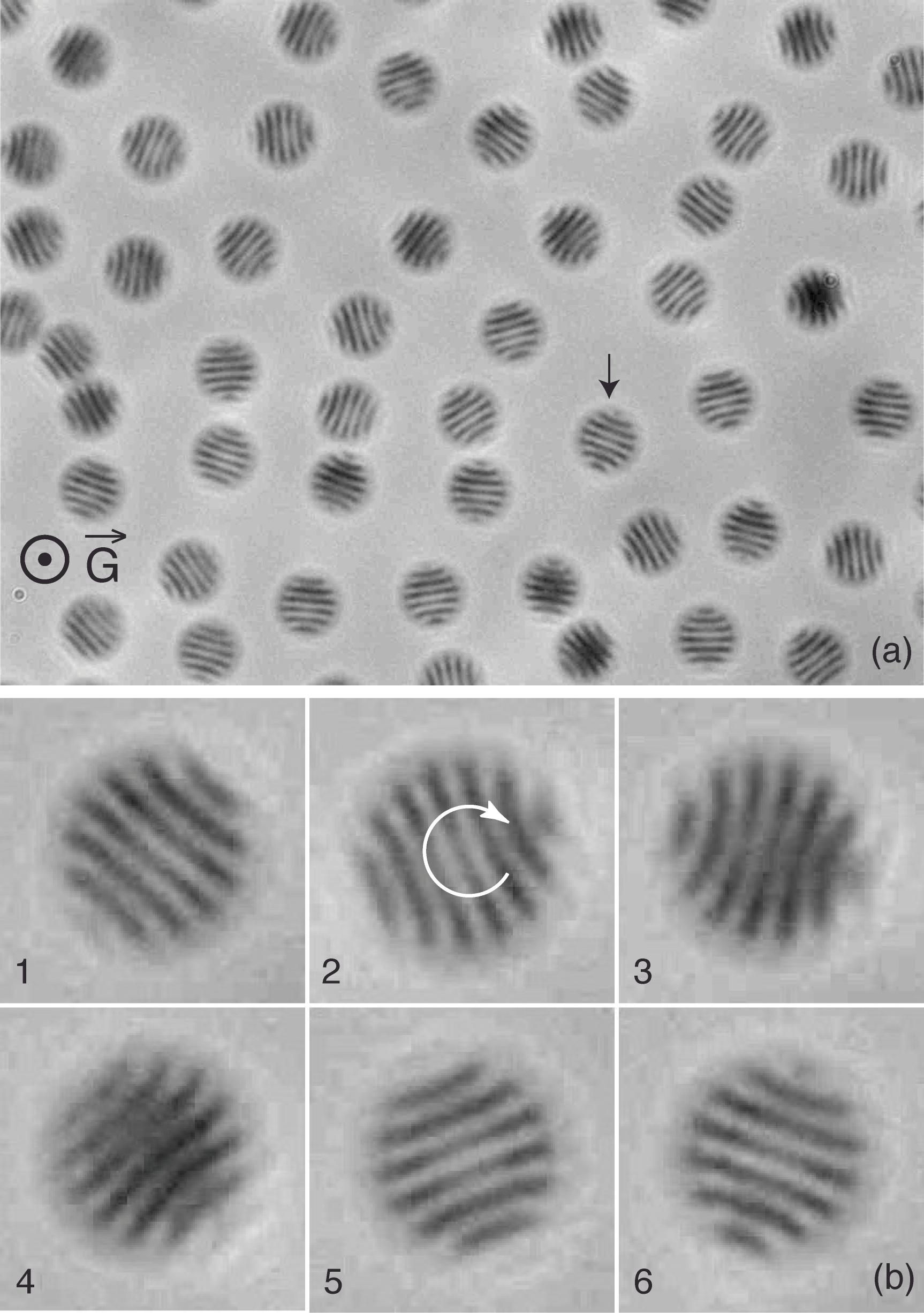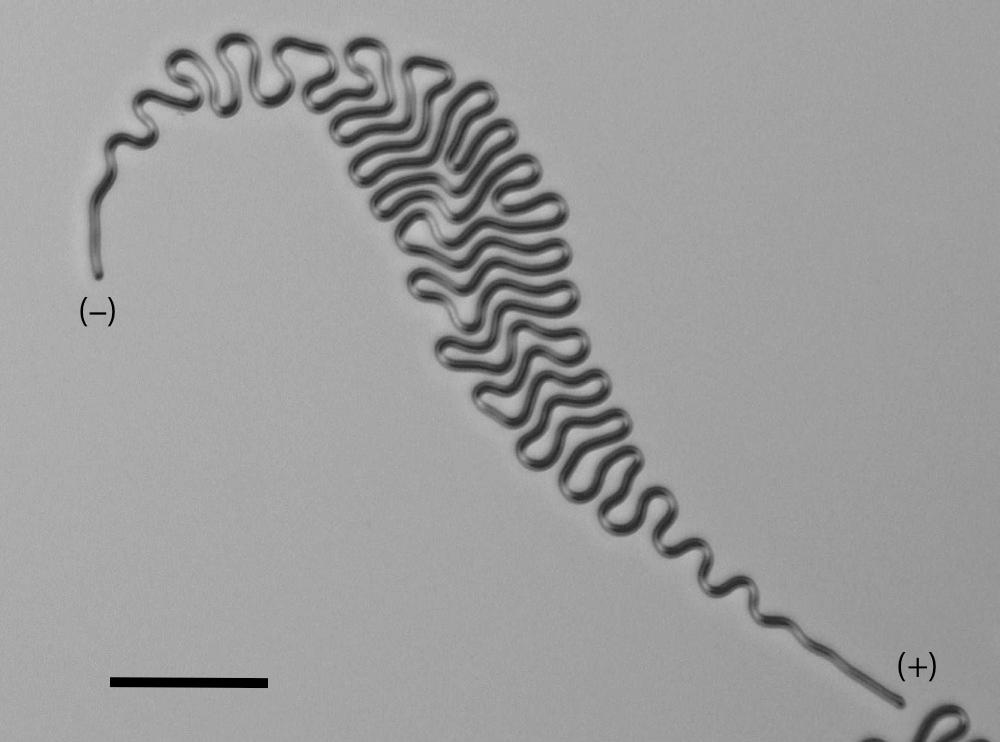Lehmann effect in cholesteric liquid crystals
A. Dequidt, P. Oswald
In 1900, Otto Lehmann observed the continuous rotation of cholesteric droplets when heated from below. This thermomechanical phenomenon was explained 68 years later by Leslie from symmetry arguments. According to the theory, the director experiences a torque proportional to the temperature gradient. The proportionality constant is called the Lehmann coefficient. The concept of Lehmann effect was extended by de Gennes in 1973 to the electric and chemical cases, a gradient of electric or chemical potential being formally equivalent to a temperature gradient.
In order to measure the thermal Lehmann coefficient, we performed several experiments.
The first one was similar to that performed by Eber and Janossy in 1982. In this static experiment, a compensated cholesteric liquid crystal (mixture of the cyanobiphenyl liquid crystal 8OCB and of cholesteryl chloride in mass proportion 1:1) is sandwiched between two glass plates treated for homeotropic anchoring. This sample is placed in a temperature gradient parallel to the plates. Eber and Janossy observed that the sample became birefringent at the compensation temperature Tc (at which the cholesteric unwinds) in the presence of a temperature gradient. This phenomenon was interpreted in terms of Lehmann effect by these authors who determined the first experimental value of the Lehmann coefficient in a cholesteric phase at Tc. This result was questioned by theorists (H. Pleiner and H.R. Brand) who claimed that the Lehmann effect should necessarily vanish at Tc. For this reason, we conducted very carefully a similar experiment in two complementary geometries (homeotropic and planar) [1,2]. Our results agree with those of Eber and Janossy, confirming that the Lehmann effect exists in cholesterics at Tc. This result is not so surprising as a cholesteric at Tc has not the same symmetry group as an usual nematic phase, because of the chirality of the molecules, a point that theorists did not realize at the time.
 Image: Extinction branches of a disclination line rotating at a constant rate under the action of a temperature gradient in a sample treated for planar and sliding anchoring.
Image: Extinction branches of a disclination line rotating at a constant rate under the action of a temperature gradient in a sample treated for planar and sliding anchoring.
In order to confirm these results we performed a more direct experiment in the geometry depicted by de Gennes in his book. That time, the sample is prepared between two glass plates treated for planar and sliding anchoring. In this geometry the helix is perpendicular to the glass plates. By imposing a temperature gradient across the sample, we observed a continuous rotation of the director [2,3,4] (figure above). This experiment allowed us to measure directly the Lehmann coefficient at Tc and in its vicinity and to confirm that this coefficient does not vanish nor change sign at Tc. This result was also confirmed by observing the drift of cholesteric fingers on both sides of Tc in homeotropic samples subjected to a temperature gradient [5]. In this case, the Lehmann torque makes drift the fingers which form rotating spirals (figure below).

Image: Cholesteric fingers forming a triple spiral rotating counterclockwise under the action of a temperature gradient.
We also reproduced (for the first time, to our knowledge) the original Lehmann experiment with the compensated mixture [6] and more recently with an usual mixture (eutectic mixture of cyanobiphenyls 8CB and 8OCB doped with a small amount of the chiral molecule R811) [7,8]. In all cases, we observed that droplets with a banded texture form at the coexistence temperature with the isotropic liquid and rotate continuously under the action of a temperature gradient. Their angular velocity strongly depends on their size and on the concentration of chiral molecules. These experiments allowed us to estimate the Lehmann coefficient at the clearing temperature by using three complementary methods. The first one consisted of measuring the droplet angular velocity as a function of the droplet size. The second one consisted of applying an electric field to stop the droplet rotation. The last one (only possible in large-pitch cholesteric mixtures) consisted of observing below which critical size the drops stop rotating because of a textural change. The three methods led to consistent values of the Lehmann coefficient at the clearing temperature. One interesting result is that the Lehmann coefficient seems to strongly increase when approaching the clearing temperature.
 Cholesteric droplets observed in natural light. They all rotate in the same direction when the sample is subjected to a temperature gradient. Top: General view of the sample; Bottom: Sequence of images showing the rotation of an isolated droplet.
Cholesteric droplets observed in natural light. They all rotate in the same direction when the sample is subjected to a temperature gradient. Top: General view of the sample; Bottom: Sequence of images showing the rotation of an isolated droplet.
We also revisited previous experiments about the electric Lehmann effect [9]. In all cases we realized that it was possible to explain the observed phenomena without appealing for an electric Lehmann effect. In particular we repeated the Padmini and Madhusudana experiment. Although we found similar experimental results, we demonstrated by extending this experiment to another geometry, that they were incompatible with an electric Lehmann effect. By contrast, an explanation based only on flexoelectricity allowed us to interpret all the data [9].
To conclude, we believe that there is currently no clear experimental evidence for the electric Lehmann effect [10].
 Finally, we observed the circular growth of the cholesteric fingers when they are subjected to the combined action of a temperature gradient and an AC electric field [11]. This effect is caused by the Lehmann torque and could be useful to measure the Lehmann coefficient on condition to solve numerically the tip trajectories.
Finally, we observed the circular growth of the cholesteric fingers when they are subjected to the combined action of a temperature gradient and an AC electric field [11]. This effect is caused by the Lehmann torque and could be useful to measure the Lehmann coefficient on condition to solve numerically the tip trajectories.
[1] A. Dequidt, P. Oswald, Lehmann effect in compensated cholesteric liquid crystals, Europhysics Letters, 80 (2007) 26001.
[2] A. Dequidt, A. Zywocinski, P. Oswald, Lehmann coefficient in a compensated cholesteric liquid crystal: measurements with fixed and gliding boundary conditions, Eur. Phys. J. E, 25 (2008) 277.
[3] P. Oswald, A. Dequidt, Direct measurement of the thermomechanical Lehmann coefficient in a compensated cholesteric liquid crystal, Europhys. Lett., 83 (2008) 16005.
[4] P. Oswald, A. Dequidt, Reply to Comment on `Direct measurement of the thermomechanical Lehmann coefficient in a compensated cholesteric liquid crystal, Europhys. Lett., in press.
[5] P. Oswald, A. Dequidt, Thermomechanically driven spirals in a cholesteric liquid crystal, Phys. Rev. E, 77 (2008) 051706.
[6] P. Oswald, A. Dequidt, Measurement of the continuous Lehmann rotation of cholesteric droplets subjected to a temperature gradient, Phys. Rev. Lett., 100 (2008) 217802.
[7] P. Oswald, Lehmann rotation of cholesteric droplets subjected to a temperature gradientÊ: role of the concentration of chiral molecules, Eur. Phys. J. E., 28 (2009) 377-383.
[8] P. Oswald, Highlights on Lehmann effect in cholesteric liquid crystals, Europhysics News, 40 (3) (2009) 13.
[9] A. Dequidt, P. Oswald, Does electric Lehmann effect exist in cholesteric liquid crystals, Eur. Phys. J. E, 24 (2007) 157.
[10] P. Oswald, A. Dequidt, Lehmann effect in chiral liquid crystals and Langmuir monolayers: an experimental survey, Liq. Cryst., 36 (10) (2009) 1071-1084.
[11] P. Oswald, Experimental Study of the growth of cholesteric fingers subjected to an AC electric field and a temperature gradient, Liq. Cryst., 36 (9) (2009) 967-975.




